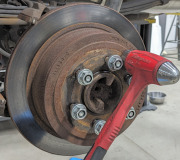Dandy. New rotors often warp and need one light machining, then they are okay. That affects Chinese rotors. We age cast iron parts for ninety days before they get their final machining; they do not, so they age on your car. Other than that, there is nothing wrong with their quality.
The first thing to look at is the rotor thickness. There is a published legal minimum thickness they can be machined to, ("machine to" spec), and a smaller "discard" spec they can be allowed to wear to after they have been machined. Besides the legal ramifications that all professionals know about and obsess over, if they are too thin, there will not be enough metal to dissipate the heat. Hit a hot rotor with water from a puddle, and there is a good chance it will warp.
Check for missing splash shields, especially given the age of the car. They help direct cooling air to the rotors and keep water off of them.
If the rotors are full of deep rust pockets on the backside, it is time to replace them. You cannot get even friction on both sides of the car.
The next thing to consider is a dragging brake. Suspension geometry has been modified on front-wheel-drive cars to prevent a brake pull when one brake hydraulic circuit stops working, so you will often not notice the car pulling to one side when a brake is sticking. Stop on a slight incline, shift to neutral, release the brakes, then see if the car creeps downhill on its own. If it does not, a brake is sticking. Everyone assumes the calipers are causing that, but it is more common to have a restricted rubber flex hose. To find that, you have to open the hydraulic system at various places to see where the brake fluid is being trapped. Start with the steel lines at the master cylinder. If that lets the brakes release, we have to talk. Contaminated brake fluid will cause that, and that is a very expensive repair, possibly more than the car is worth.
Also look at the calipers' mounting surfaces. If there is insufficient brake grease on them, grooves will wear into them and allow the pads' backing plates to catch and resist releasing. That can keep one pad in contact with the rotor and cause it to get hot. You can often find that by feeling the unequal temperatures next to the two front wheels after a drive on the highway.
The last thing is hot spots. Cutting bits will skip over them but you may not feel that right away. As the softer metal wears down, the hot spots are much harder so they do not wear as fast. In effect, it looks like those spots raise up over time until you feel it in the pedal.
Friday, February 26th, 2016 AT 2:21 PM



